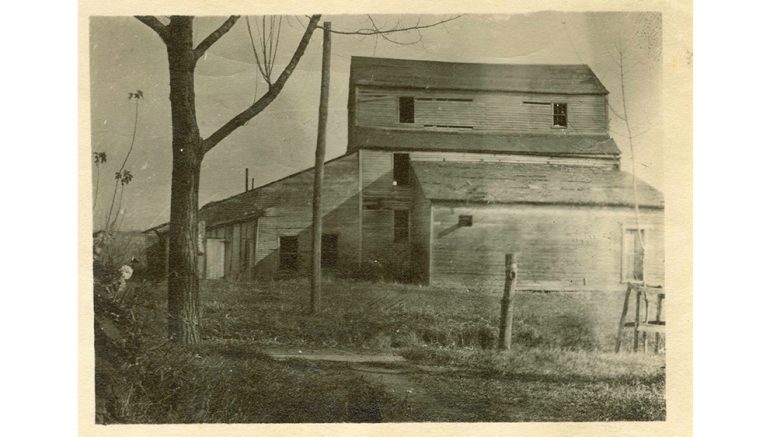Submitted by Hamilton County Bicentennial Commission
Guest contributor and historian Brendan White shares the story of a long-gone business that became an important part of the agricultural heritage of Westfield.
White is a frequent historical society volunteer who has a true passion for Hamilton County’s past. He is also a contributing writer to Celebrating Hamilton County, Indiana: 200 Years of Change, the official Bicentennial history book available to order now.
* * *
Among the businesses employing and serving residents of Westfield during the town’s earliest days was the Westfield Flour Mill. From 1848 to around 1917, it emerged as a major industry with an unusually long record of ownership changes.
T.B. Helm provides some information about the mill in his 1880 History of Hamilton County, Indiana, while the book Our Westfield (1984) includes an article written by Byford F. Inman for The News on July 27, 1917.
Changing hands at breakneck speed
The Westfield Flour Mill was the first flour mill in Westfield. Isaac Williams & Company built the mill south and east of Penn Street on the east side of town in 1848. Williams and his company operated the business inside a three-story structure (37 feet wide and 40 feet long) before selling his interest to J.L. Semans in 1854.
For a short time, Semans partnered with Peter Rich, who owned half of the interest in the mill until selling it to Jonathan E. Pike in 1855. Micajah C. White & Company bought the half interest from Pike in 1857, followed by Joshua Wilson in 1858. During that year, Semans purchased the half interest from Wilson, making him the sole owner of the mill until selling a half interest to Jabez Neal in 1864.
Abner Atkison bought the other half interest from Semans in 1867. In 1868, Neal sold his half interest in the mill to Thomas Stout, who then sold it to Stephen Harvey three years later. Harvey purchased the other half interest from Atkison in 1868.
Because the owners didn’t pay the mortgage held by J.L. Semans against the mill, the Hamilton County Sheriff sold the property to Semans in 1871. Semans later sold the mill to some local citizens, but the mill went into receivership and then under the possession of Henry C. Long. A front-page advertisement in the Noblesville Daily Ledger from January 7, 1887, shows that W.S. Christian, John Vail and G.S. Christian owned the mill, which was also called the “Westfield Roller Mill.” These three men would have been the owners of the mill sometime after Semans and before the enterprise went into receivership.
Thomas Thompson, a native of Indianapolis, purchased the mill from Long, and then Hill & Smiley (William C. Hill of Westfield and Levi Smiley of Noblesville) acquired it from Thompson in either 1902 or 1905. Other later owners of the mill included F.H. McKnight, John C. Hinshaw and Blanche Johnson. The last owner was a business called Dorman Brothers, a Noblesville junk dealer.
New owners led to new business foci
Along with the mill’s frequent ownership shifts came changes in operations. Under the ownership of J.L. Semans in 1862, a woolen mill was added, which operated until 1873. A new engine and boiler had been installed in the mill by the time Thomas Stout purchased it in 1868.
After purchasing the mill from the sheriff in 1871, Semans owned and operated it for several years starting in March 1872, producing up to 60 barrels of flour every day.
When they assumed ownership, Hill & Smiley restored the mill and continued to produce flour, but the mill switched to grinding grain into animal feed after their ownership ended.
The Westfield Flour Mill’s demolition
In an article in The News by Byford F. Inman, who was best known for penning the song “Glory to Old Westfield” at Westfield High School in 1912, writes that local carpenter C.C. Gurley demolished the mill in 1917.
The site of the Westfield Flour Mill is now a vacant lot just south and east of the end of Penn Street, or at the northeast corner of East and Main streets (State Road 32). It was also across the street from the home where Inman lived until his death in 1980.
Although the mill no longer exists, it remains part of the rural heritage of Westfield today.
Brendan White works part time at the Sheridan Historical Society and Arcadia Depot. He also volunteers at the Westfield Washington Historical Society, Greentown Historical Society, Tipton County Historical Society, Carmel Clay Historical Society and Hamilton County Historical Society. He graduated from Indiana University Kokomo with a bachelor’s degree in history and political science and earned a master’s degree in history at Ball State University.
* * *
Don’t miss a Hamilton County history beat! Sign up for our weekly newsletter to receive local history, updates on upcoming Bicentennial programs and more.
The Hamilton County Bicentennial is proudly supported by Duke Energy, Hamilton County Board of Commissioners, Hamilton Country Tourism Inc., and Hamilton County Historical Society.


ENJOY ALL THIS INFORMATION ON WESTFIELD